Sedum false: description and varieties, planting and care

Today, flower growers and gardeners have the opportunity to grow a huge number of different plants. Among the attractive crops that lend themselves to cultivation in the open field, as well as at home, it is worth highlighting sedum, which is in great demand in light of its decorative appeal.

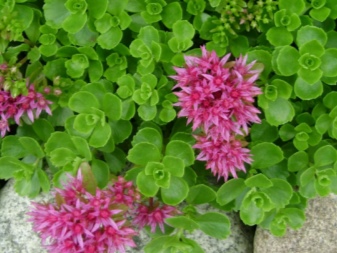
Peculiarities
This culture has several names that are common among gardeners. Therefore, sedum false is sometimes referred to as Caucasian sedum. This name gives an understanding of where the plant comes from. In the wild, sedum grows in Georgia, in the western part of Armenia, in the Ciscaucasia. And also the culture is found in Turkey and Iran. Based on its characteristics, sedum is a herbaceous crop that prefers to grow on slopes, as well as in meadows.


As the practice of sedum cultivation shows, it adapts well to the climatic features of the northern regions of Russia, since the plant has inherent properties to maintain its viability even at negative air temperatures.
According to the botanical description, sedum is a ground cover perennial that increases in height by no more than 25-30 centimeters. Among the individual varieties, there are representatives of the succulent, which can grow in height only up to 5 centimeters. The root system is represented by many branched thin roots, stonecrop stems, taking into account the variety, are of two types - creeping or ascending.
Fruitless shoots are usually shorter than fertile ones by 3-5 centimeters, on the latter, in the process of culture development, fruits are formed. The green mass is represented by leaves of saturated color, which develop oppositely. As a rule, the length of the plate is from 1 to 3 centimeters with a width of no more than 1 centimeter. The leaf is wedge-shaped with minimal pubescence.

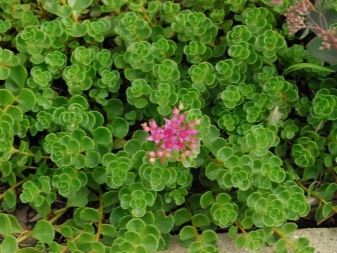
Sedum inflorescences are spreading umbrellas that grow between twisting shoots. Rosettes are represented by a large number of small flowers, which can be painted in white, pink, crimson and other colors, depending on the variety. The culture enters the flowering phase at the beginning of summer, maintaining the freshness of its flowers until August.


The plant will be able to bloom already in the second year of life, when the formation of the bulk of the shoots ends. In the wild, flowering can be represented by a green carpet with small attractive multi-colored rosettes on top. When growing stonecrop at home, it can be extremely difficult to achieve its flowering.
Sedum fruits contain a large number of dusty seeds, which are characterized by high vitality rates. At the end of summer, most species of stonecrop throw off their leaves.
The culture is perennial, however, when grown for decorative purposes, it will require regular renewal, which will have a positive effect on its attractiveness. It is recommended to recite at least once every 5-6 years.


Varieties
Among the available representatives of this culture, it is worth highlighting the most in demand.
Sedum false crimson
A culture that develops up to 20-25 centimeters.Creeping shoots, green mass is painted in a rich shade. Due to its structure, the plant tightly covers the ground. Some stonecrops can be up to 50 centimeters in diameter. The leaves are strong, at the ends may contain jaggedness at a size of 4x6 centimeters.
Inflorescences grow in the form of a shield, the color of the flowers will be purple-red, there are also plants with pink color of the petals. Flowering lasts about 1.5-2 months starting in June. However, the sedum may enter the flowering phase later in the light of the climatic features of the region where it grows. In autumn, the perennial sheds its foliage.
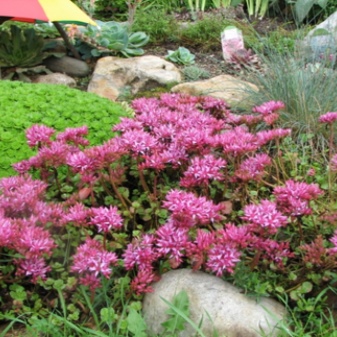
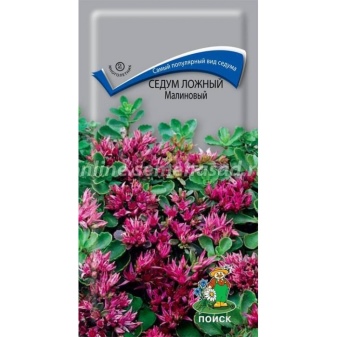
"Tricolor"
A variety that grows up to 15 centimeters in height. The foliage is medium in size, but this does not prevent the plant from forming an attractive flowering carpet on the ground during its development. Sedum owes its name to the color of the leaves, which are plates with stripes of green and white, and with the arrival of autumn, pink is added to the main shades. The green mass has an elongated shape, there are notches at the ends of the leaf. The culture reaches its peak of its decorative attractiveness in sunny areas of the garden. The inflorescences are white-pink in color.

Roseum
The succulent has creeping stems that lengthen by 15-20 centimeters, shoots containing flower stalks usually grow up to 25 centimeters. The culture can grow in size quite quickly. The sedum enters the flowering phase in June, decorating the site until the end of summer. The flowering is abundant, so the green mass among the numerous pink flowers may be poorly visible.


"Koktsineum"
Sedum, 20 centimeters high with oval-shaped green leaves. Some representatives have a reddish tint in color. The plant blooms with beautiful pink flowers that look like stars in appearance, with a diameter of no more than 1 centimeter.
During the flowering period, the culture exudes a pleasant aroma. Typically, sedum will be decorated with flowers from July to August.


"Green mantle"
A small succulent plant that grows up to a maximum of 10 centimeters. The foliage is dense, has an emerald color with a rounded plate. The bloom will initially be white, then the inflorescences change their shade to pink.


Also among the popular varieties it is worth highlighting:
- Fuldaglut;
- "Blush";
- Voodoo and others.

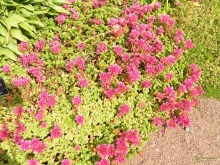

How to plant?
For all succulents, it is important that the site chosen for rooting is with maximum access to sunny color, since the culture loses its attractiveness in the shade. If the lighting in the garden or at home is bright, then the flowering and shades will be as saturated as possible.
As for the choice of a suitable type of soil, the perennial perfectly adapts to any soil in terms of composition, the main thing is that the gardener takes care of the presence of good drainage in the hole. Planting sedum in the lowlands should be abandoned, since moisture can stagnate in the soil in such areas.
The plant can be rooted at any time of the year, however, the most favorable period for this will be spring, since the young plant will have time to adapt to new conditions over the summer, as well as increase the green mass.

The planting algorithm assumes the deepening of the crop cuttings with the previously removed lower leaves into the soil. Then the soil is compacted and moistened. For home breeding, wide pots or other containers are usually used, but their depth should not be large, since the culture has a creeping root system: it does not go deep into the ground, but is located close to the surface.

How to take care of it properly?
Once the sedum is rooted, the crop will need to be properly cared for to grow. Agrotechnical measures should not cause any problems even for beginners, however, in the first few weeks after planting, it is recommended to pay maximum attention to sedum. The main care work involves several activities.
Weeding
During the first month for a plant rooted outdoors, weeding will be important, as the weed can destroy sedum, preventing it from rooting. Until the sedum forms a dense green carpet on the site, the gardener needs to remove all weeds near it.

Watering
Succulents do not need frequent hydration. In cases where the culture grows in regions with high humidity, and the air temperature rarely rises above + 22 ° C, there will be no need to water the perennial at all. The introduction of moisture will be required by the plant during the hot months.
Such work is best carried out in the evening, avoiding the formation of a crust on the surface of the soil.

Change of seasons
Indoor crops will require the grower to provide the plant with a natural change of seasons. So that the perennial has the opportunity to be in a dormant phase, which is replaced by an active time of growth and flowering. In the first case, for the culture it is necessary to provide an air temperature within + 8 ... 15 ° С, for the growing season it will be enough to keep a flower in the temperature range from + 22 ... 25 ° С.
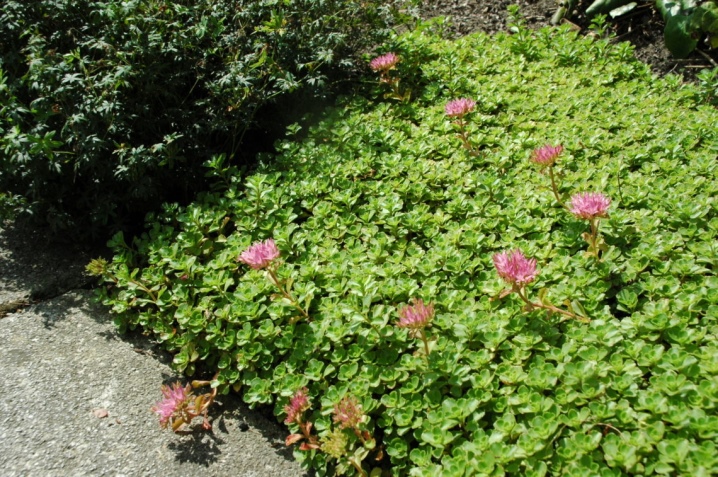
Fertilizer
If the culture was originally planted in fertile soil, then it does not need to be fed. If trace elements are in excess, then this can lead to an active build-up of green mass without flowering.
In poor soil or in areas with rocky soil, it is most correct to feed the plant with a special mineral complex recommended for succulents before the flowering phase.

Pruning
To maintain the attractiveness of stonecrop, woody shoots are removed. Such work can be combined with sanitary pruning, when dry leaves or inflorescences are removed from the crop.

Reproduction methods
Perennial can be propagated in several ways.
Cuttings
To obtain planting material, it is necessary to separate young shoots with roots from the mother bush. Or choose the upper part of the shoot about 10 centimeters long, rooting it into a moist substrate.

Seed method
To get a crop on your own, you can also use the option of growing sedum from seeds, which breeders practice to breed new varieties. The collected or purchased material is sown in spring in containers, regularly moistening the soil by spraying. Glass or film is used to create a greenhouse effect. It is recommended to keep containers at a temperature of + 5 ... 7 ° С for hardening. Further, the emergence of sprouts is awaited indoors at room temperature. A culture with three leaves can already be transplanted into a separate container for development.

Dividing the bush
A variant involving the digging of an adult perennial, followed by dividing it into several parts with roots and 2 buds. Each culture, after processing the cut sites, is immediately rooted at the selected site.

Diseases and pests
In general, the culture is distinguished by immunity to many diseases, but with an excess of moisture it can suffer from a fungus. Signs of the disease are dark spots on the green mass. Treatment consists in removing the affected parts, as well as normalizing the frequency of watering.
Among the insects that pose a danger to stonecrop, it is worth highlighting:
- thrips;
- aphids;
- weevil.
To destroy the pest, it is recommended to use a soapy solution for spraying or store-bought insecticides with a large number of insects.

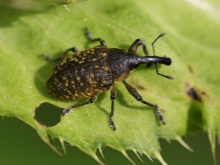

Use in landscape design
A perennial can be successfully grown in a garden with low decorative trees, forming a blooming green carpet under them.
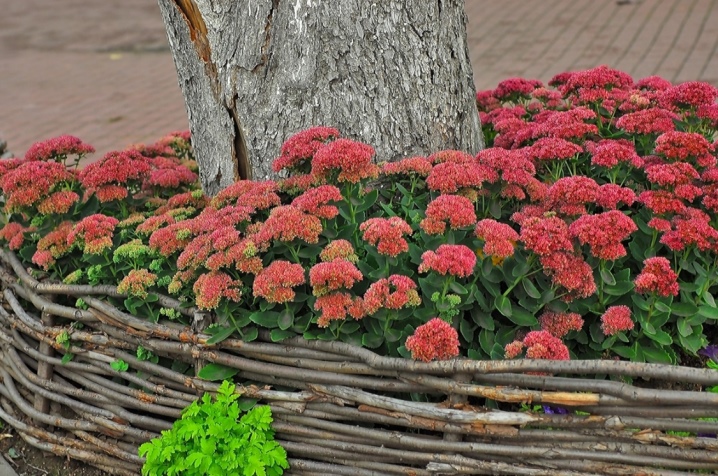
Even miniature varieties of succulents can become a decoration in a flower bed due to their visual appeal and bright flowering.

The sedum blends perfectly with garden crops, in the light of which, with the help of a perennial in the garden, it will be possible to create picturesque flower arrangements.

How to grow stonecrop, see the next video.






































































































The comment was sent successfully.